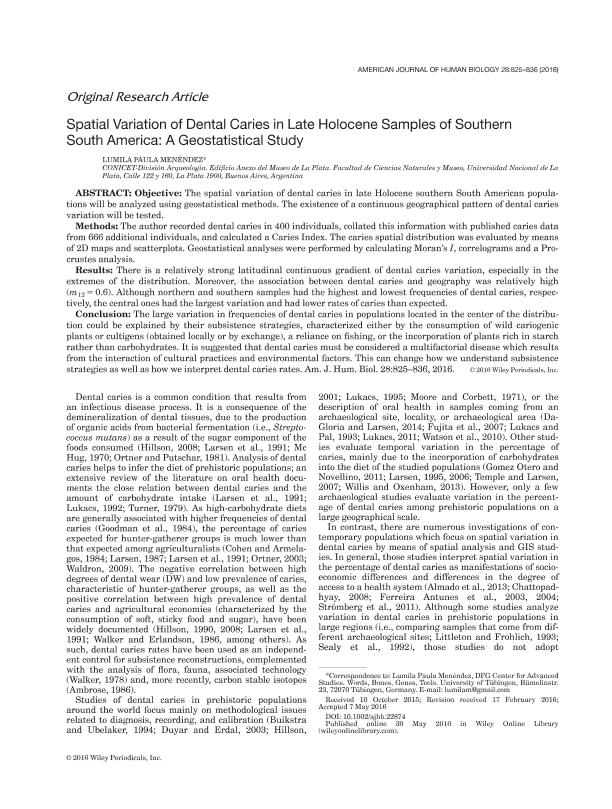Mostrar el registro sencillo del ítem
dc.contributor.author
Menendez, Lumila Paula

dc.date.available
2018-08-06T18:08:38Z
dc.date.issued
2016-05
dc.identifier.citation
Menendez, Lumila Paula; Spatial Variation of Dental Caries in Late Holocene Samples of Southern South America: a Geostatistical Study; Wiley-liss, Div John Wiley & Sons Inc; American Journal of Human Biology; 28; 5-2016; 825-836
dc.identifier.issn
1042-0533
dc.identifier.uri
http://hdl.handle.net/11336/54285
dc.description.abstract
Objective: The spatial variation of dental caries in late Holocene Southern South American populationswill be analyzed using geostatistical methods. The existence of a continuous geographical pattern ofdental caries variation will be tested. Methods: The author recorded dental caries in 400 individuals andcollated this information with published caries data from 666 individuals. Then, a Caries Index (CI) wascalculated. The caries spatial distribution was evaluated by means of 2D maps and scatterplots.Geostatistical analyses were performed by calculating Moran´s I, correlograms and a Procrustes analysis.Results: There is a relatively strong latitudinal continuous gradient of dental caries variation, especiallyin the extremes of the distribution. Moreover, the association between dental caries and geography wasrelatively high (m12=0.6). Although Northern and Southern samples had the highest and lowestfrequencies of dental caries respectively, the central ones had the largest variation and, they had lowerrates of caries than expected. Conclusion: The large variation in frequencies of dental caries of thepopulations located in the center of the distribution could be explained by their subsistence strategies,characterized either by the consumption of wild cariogenic plants or cultigens obtained locally or byexchange, a reliance on fishing or the incorporation of plants rich in starch rather than carbohydrates. Itis suggested that dental caries must be considered a multifactorial disease, which results from theinteraction of cultural practices and environmental factors, and can change how we understandsubsistence strategies and how we interpret dental caries rates.
dc.format
application/pdf
dc.language.iso
eng
dc.publisher
Wiley-liss, Div John Wiley & Sons Inc

dc.rights
info:eu-repo/semantics/openAccess
dc.rights.uri
https://creativecommons.org/licenses/by-nc-sa/2.5/ar/
dc.subject
Dental Caries
dc.subject
Spatial Variation
dc.subject
Geostatistics
dc.subject
Late Holocene
dc.subject
Southern South America
dc.subject.classification
Historia

dc.subject.classification
Historia y Arqueología

dc.subject.classification
HUMANIDADES

dc.title
Spatial Variation of Dental Caries in Late Holocene Samples of Southern South America: a Geostatistical Study
dc.type
info:eu-repo/semantics/article
dc.type
info:ar-repo/semantics/artículo
dc.type
info:eu-repo/semantics/publishedVersion
dc.date.updated
2018-08-06T17:42:25Z
dc.journal.volume
28
dc.journal.pagination
825-836
dc.journal.pais
Estados Unidos

dc.journal.ciudad
Nueva York
dc.description.fil
Fil: Menendez, Lumila Paula. Consejo Nacional de Investigaciones Científicas y Técnicas; Argentina. Universidad Nacional de La Plata. Facultad de Ciencias Naturales y Museo. División Arqueología; Argentina
dc.journal.title
American Journal of Human Biology

dc.relation.alternativeid
info:eu-repo/semantics/altIdentifier/doi/https://dx.doi.org/10.1002/ajhb.22874
dc.relation.alternativeid
info:eu-repo/semantics/altIdentifier/url/https://onlinelibrary.wiley.com/doi/abs/10.1002/ajhb.22874
Archivos asociados
